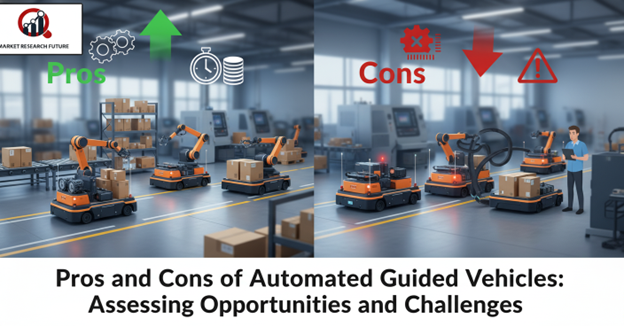Pros and Cons of Automated Guided Vehicles

Automated Guided Vehicle Market Overview
The global Automated Guided Vehicle (AGV) market is expanding rapidly as industries increasingly embrace automation to enhance operational efficiency, reduce labor costs, and improve workplace safety. AGVs—also referred to as self-guided or autonomous guided vehicles—are material handling systems capable of navigating warehouses, distribution centers, and manufacturing plants without human operators.
Driven by growing industrialization, e-commerce proliferation, and demand for efficient supply chain management, AGVs are now integral to sectors such as logistics, automotive, healthcare, manufacturing, and food & beverage. However, the market presents both opportunities and challenges. High initial costs, technology integration, and workforce adaptation remain key considerations for businesses looking to adopt AGVs.
What Are Automated Guided Vehicles?
AGVs are autonomous machines designed to transport materials within industrial and commercial facilities. Equipped with sensors, navigation systems, and programmable software, they can perform repetitive material handling tasks with precision, consistency, and safety.
Common AGV types include:
- Tugger AGVs – Pull trolleys or carts to transport bulk goods
- Unit Load AGVs – Carry individual pallets or containers
- Forklift AGVs – Automate traditional forklift tasks
- Assembly Line AGVs – Move components along production lines
AGVs can integrate with warehouse management systems (WMS) and enterprise resource planning (ERP) software to optimize logistics operations and provide real-time inventory tracking.
Shifting Industry Dynamics
Modern industries are increasingly automation-driven, emphasizing efficiency, accuracy, and operational safety. AGVs align with these objectives by enabling:
- Reduced labor dependence and associated costs
- Minimized product damage during transportation
- Streamlined production and assembly line operations
- Improved safety standards by reducing human-vehicle interactions
The rising adoption of AGVs is especially evident in the automotive and e-commerce sectors. For instance, AUDI AG employs AGVs to track component availability and transport supplies safely within production facilities. Similarly, JBT’s acquisition of Urtasun Tecnologia Alimentaria illustrates the integration of automated solutions in the food and beverage industry, expanding service capabilities globally.
Key Market Growth Drivers
- Cost Optimization and Efficiency
AGVs reduce labor dependency, operational bottlenecks, and human error, thereby improving overall productivity and throughput.
- E-commerce Expansion
The rise of online retail, single-day delivery demands, and third-party fulfilment centres has accelerated AGV deployment in warehouses to ensure faster, reliable operations.
- Industrial Automation Trends
Growing adoption of automated storage and retrieval systems (AS/RS), robotic material handling equipment, and modern warehouse infrastructure is driving market expansion.
- Technological Advancements
Innovations in navigation technologies (laser, magnetic, and vision-based guidance), battery life, and sensor integration are enhancing AGV functionality and reducing operational limitations.
- Urbanization and Manufacturing Growth
Rapid industrialization in Asia-Pacific, coupled with expanding urban logistics networks, fuels demand for autonomous material handling solutions.
Challenges and Considerations
Despite strong growth, AGVs face certain challenges:
- High Initial Costs: Significant capital investment for acquisition, integration, and maintenance can deter small and medium-sized enterprises (SMEs).
- Technological Complexity: Battery types, navigation systems, and sensor calibration require skilled personnel and technical expertise.
- Workforce Adaptation: Staff training is essential to manage AGVs and maintain operational safety.
- Integration Challenges: Compatibility with existing warehouse management systems and production processes can be complex.
- Limited Adoption in SMEs: Smaller firms often struggle with ROI and upfront investment, despite rising labour costs.
Overcoming these barriers requires strategic planning, workforce upskilling, and scalable technology solutions.
Regional Insights
- Asia-Pacific: Poised to lead the global market with a projected stellar CAGR, driven by urbanization, booming e-commerce, and industrial automation in countries such as China, India, and Indonesia. China alone accounts for ~40% of global e-commerce retail sales, offering significant AGV adoption potential.
- North America: Mature market with established logistics and manufacturing infrastructure; high emphasis on technology integration and safety compliance.
- Europe: Focus on advanced automation and Industry 4.0 integration; significant adoption in automotive and food & beverage sectors.
- Latin America & Middle East/Africa: Emerging regions benefiting from global technology suppliers, growing warehousing investments, and expanding manufacturing bases.
Future Outlook
The AGV market is expected to grow steadily, with demand fueled by:
- Rising e-commerce fulfillment needs
- Industrial automation trends
- Expansion of smart warehouses and manufacturing plants
- Technological innovations in navigation, AI, and fleet management
The coming years are likely to witness hybrid autonomous solutions, collaborative AGVs, and integration with IoT platforms, enabling scalable, safe, and efficient material handling systems.
Conclusion
Automated Guided Vehicles are transforming material handling and logistics by enhancing efficiency, safety, and productivity. While challenges such as high capital expenditure and technological complexity exist, the long-term benefits make AGVs a cornerstone of modern warehouse, manufacturing, and e-commerce operations.
With rising industrial automation, increasing e-commerce penetration, and technological advancements, AGVs are set to become mainstream solutions, particularly in the Asia-Pacific region, supporting a global shift toward autonomous material handling.

Leave a Comment